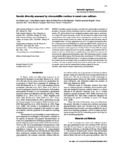Use este identificador para citar ou linkar para este item:
http://www.alice.cnptia.embrapa.br/alice/handle/doc/1035081Registro completo de metadados
| Campo DC | Valor | Idioma |
|---|---|---|
| dc.contributor.author | LOPES, A. D. | pt_BR |
| dc.contributor.author | SCAPIM, C. A. | pt_BR |
| dc.contributor.author | MACHADO, M. de F. P. da S. | pt_BR |
| dc.contributor.author | MANGOLIN, C. A. | pt_BR |
| dc.contributor.author | SILVA, T. A. | pt_BR |
| dc.contributor.author | CANTAGALI, L. B. | pt_BR |
| dc.contributor.author | TEIXEIRA, F. F. | pt_BR |
| dc.contributor.author | MORA, F. | pt_BR |
| dc.date.accessioned | 2016-01-26T11:11:11Z | pt_BR |
| dc.date.available | 2016-01-26T11:11:11Z | pt_BR |
| dc.date.created | 2016-01-26 | pt_BR |
| dc.date.issued | 2015 | pt_BR |
| dc.identifier.citation | Scientia Agrícola, Piracicaba, v. 72, n. 6, p. 513-519, nov./dez. 2015. | pt_BR |
| dc.identifier.uri | http://www.alice.cnptia.embrapa.br/alice/handle/doc/1035081 | pt_BR |
| dc.description | Information on genetic diversity is essential to the characterization and utilization of germplasm. The genetic diversity of twenty-two sweet corn cultivars (seventeen open-pollinated varieties, OPV, and five hybrids, H) was investigated by applying simple sequence repeat markers. A total of 257 primers were tested, of which 160 were found to be usable in terms of high reproducibility for all the samples tested; 45 were polymorphic loci, of which 30 were used to assess the genetic diversity of sweet corn cultivars. We detected a total of 86 alleles using 30 microsatellite primers. The mean polymorphism was 82 %. The highest heterozygosity values (Ho = 0.20) were found in the PR030-Doce Flor da Serra and BR427 III OPVs, whereas the lowest values (0.14) were recorded in the MG161-Branco Doce and Doce Cubano OPVs. The polymorphism information content ranged from 0.19 (Umc2319) to 0.71 (Umc2205). The analysis of molecular variance revealed that most of the genetic variability was concentrated within the cultivars of sweet corn (75 %), with less variability between them (25 %). The consensus tree derived from the neighbor-joining (NJ) algorithm using 1,000 bootstrapping replicates revealed seven genetically different groups. Nei?s diversity values varied between 0.103 (Doce do Hawai × CNPH-1 cultivars) and 0.645 (Amarelo Doce × Lili cultivars), indicating a narrow genetic basis. The Lili hybrid was the most distant cultivar, as revealed by Principal Coordinates Analysis and the NJ tree. This study on genetic diversity will be useful for planning future studies on sweet corn genetic resources and can complement the breeding programs for this crop. | pt_BR |
| dc.language.iso | por | pt_BR |
| dc.rights | openAccess | pt_BR |
| dc.subject | Diversidade genética | pt_BR |
| dc.title | Genetic diversity assessed by microsatellite markers in sweet corn cultivars. | pt_BR |
| dc.type | Artigo de periódico | pt_BR |
| dc.date.updated | 2016-02-02T11:11:11Z | pt_BR |
| dc.subject.thesagro | Germoplasma | pt_BR |
| dc.subject.thesagro | Milho | pt_BR |
| riaa.ainfo.id | 1035081 | pt_BR |
| riaa.ainfo.lastupdate | 2016-02-02 | pt_BR |
| dc.identifier.doi | http://dx.doi.org/10.1590/0103-9016-2014-0307 | pt_BR |
| dc.contributor.institution | FLAVIA FRANCA TEIXEIRA, CNPMS. | pt_BR |
| Aparece nas coleções: | Artigo em periódico indexado (CNPMS)  | |
Arquivos associados a este item:
| Arquivo | Descrição | Tamanho | Formato | |
|---|---|---|---|---|
| Geneticdiversity1.pdf | 285.52 kB | Adobe PDF |  Visualizar/Abrir |









